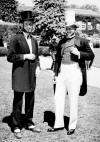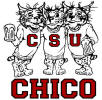click to enlarge
'58
Parade '25
Parade '41
Parade '41
Parade '47
Parade '47
Quad Area '65
Parade '79
Quad Area '79
1948
History of Pioneer Days & Pioneer Week at Chico State
Pioneer Days, Chico State University’s Old West extravaganza, has gone through some changes in its 100 year history, evolving from a single Senior Day when the college was still the Chico Normal School into a week-long festival.
The Pioneer Days saga began in 1915 with Senior Day, which was held each May to show high school seniors the teachers college campus.
Senior Day offered students lunch, musical entertainment, a tour of the college grounds and a speech by the institution’s president.
The event was discontinued during World War I, but its return in 1920 was hailed as a success because 275 students participated.
By 1925, the event had added a touch of the western influence, when students J.W. “Bill” Hamilton and Payne Euland formed a Whiskerino club. The all male social group decided to dress in Old West clothes and grow beards for a few days.
That idea caught on like a prairie fire, and club members prevailed on the campus president to combine Senior Day with a Wiskerino Day.
Whiskers were mandatory for the occasion. Those without them were jokingly hauled off by classmates. A few landed in Big Chico Creek.
But by 1927, the day fell out of favor with townspeople, who were outraged by “disgraceful costumes and random shooting.”
Following the public outcry, the event was slated to be canceled the next year, but students resurrected the celebration anyway with a different name, Nepenthe Day, which means “the drink of the gods.”
The subterfuge, and the new name, didn’t go over well with the town populace, who complained the students were doing more drinking than pioneering.
In 1929, Pioneer Day was officially established, along with many of its traditions, including the parade and the Sheriff and Little Nell selection. The first couple to be selected was Harold Spencer end Cecille Dubrow.
During the 1930s, the parade became a major feature of the day and musical comedies were a part of the program.
It was during the 1940s that Little Nell became the victim of repeated ‘kidnapping’ by rival organizations.
By 1947, the event was expanded and officially was called Pioneer Week. Students began wearing costumes on the Monday of the celebration and stump speeches for Sheriff and Little Nell speeches evolved into skits and vaudeville like presentations later dubbed “Presents.”
It was around that time that what is now known as quad projects began. It was then called the Ghost Town Carnival.
In 1952, the week include a rodeo for the first time, which was known as the Wild West Show.
By this time, sororities and fraternities began wearing identical costumes as part of their campaigns for Sheriff and Little Nell.
To Bring back the days of ’49 and the days when our ancestors crossed the plains; to make the college an open house that day for visiting seniors from near-by schools: and to afford an opportunity for the students to have experience in organizing programs and carrying out traditions.
The following year, 1931, found Pioneer Day proclaimed as the “outstanding activity of the year.’ No doubt it was and has continued to be each year since then. Nineteen thirty-one saw the addition of the frosh/soph tug-o-war over Big Chico Creek. which had become ‘traditional” in 1931. Indeed this inter-class struggle was an annual event until at least 1953.
By 1938, western costumes were worn from Thursday afternoon through Saturday; the Delta Psi Delta Hangtown Dance (Friday) had become an annual event, and one or two assemblies and dances were held during the week preceding Pioneer Day “to get people in the spirit.” During these years, it was mandatory, with violators subject to a kangaroo court trial, for all students to wear western outfits and all males to grow what whiskers they could. Further, Little Nell and Sheriff elections were held a advance of Pioneer
Day, probably so they could rehearse the Saturday morning “melodrama” which became traditional in the 1930s. The melodrama featured the classic story of the heroine (Little Nell) in grave danger of harm at the hands of the villain, rescued just in time by the hero (Sheriff).
The major attraction of Pioneer Day in the 1930s was the parade, with up to 40,000 spectators turning out to watch. The number of spectators has rarely exceeded the large crowds of the 1930s, although the number of parade entries has increased. The 1930’s entries went up to 30 or 35, including faculty entries, but by 1967 this number had risen to 170.
The war years did not stop, or even slow down the expansion of Pioneer Day, despite rationing and the decline in the male population. By 1941, stump speeches which expanded into skits or presentations of candidates, were traditional for Little Nell and Sheriff candidates. The election was still held a month in advance of Pioneer Day as the melodrama continued to launch the morning activities. Also, in 1941, the Sheriff appointed an all-male posse and a group of Girl Rangers to enforce the beard and costume law on all students. This year, too, Little Nell was kidnapped for the first, time, which became a tradition that lasted until the 1960s.
1942 saw the death of the student written and produced musical. It was replaced by a student variety show. By the early 1940s Pioneer Day and its activities, stretching over a longer period of time, had become quite rowdy with much drinking and horseplay. A 1941 editorial in the Wildcat cautioned students about the Rob Newell “noise and disruption” at
The late ‘40s saw Pioneer Day grow ever larger. The celebration was referred to as “pioneer week” for the first time in the 1947 Record and by one Wildcat columnist, who wrote that Pioneer Day “is no longer a day, but a whole week of fun and frolic.” With the requirement that students begin wearing costumes on the Monday preceding Pioneer Day, it truly was a week long affair. The Little Nell and Sheriff campaigning was moved to the week just prior to Pioneer Week. Also, Little Nell now selected her sown Girl Rangers who, along with the Sheriff’s Posse, were supposed to protect her from abductors. Unfortunately, neither group was able to prevent kidnappers from invading a class in session and taking Little Nell after a brief fight, which sent one police officer down for the count. The “outlaws” were later arrested for breaking in the windows and doors of a vacant house in which they thought Little Nell was hiding.
1948 saw such activities continue, although not quite so rough. Innovation occurred in the week’s program as Little Nell and Sheriff candidates were identified with organizations for the first time, at least officially. Stump speeches and skits were moved to the week of Pioneer Week. The towns people were invited to directly participate in the week’s activities. While this participation was to be only for the 1848 centennial celebration and was not expected to become an annual affair, it did become traditional that local residents participate in the parade and later the Ghost Town carnival.
The introduction of quad projects built by campus organizations also apparently occurred in 1948. Thus, an authentic western town was created each year thereafter as the focal point for many of the week’s events. The quads grew out of elaborate campaigning devices that had been used in the past. Also that year Pioneer Week received national exposure on Mutual’s Queen for a Day radio show. A “Queen’’ later came as a special guest for Pioneer Day. Such publicity continued as Pioneer Day was promoted by students appearing on San Francisco Television programs and by getting a LIFE magazine photographer to take pictures in 1951.
Through the next few years the usual activities continued with few changes, but additional events were added. The Variety Show was put on two, then three nights during the week. In 1950, sororities wore identical costumes as part of their Little Nell campaigns. This idea became traditional for all groups, male and female, beginning in 1951. The first Wild West Show was also held in 1950, later to become the Rodeo. 1951 and ‘53 saw attempts to revive Pioneer Day as a time to host and honor high school seniors. This idea was not well received and little mention has been made of it since.
Pioneer Week 1952 saw a student seriously wounded by a blank cartridge. This and other wild happenings over the preceding few years resulted in a series of recommendations from the Board of Commissioners which were adopted for the next few years including: No classes on Friday, only weekend dances and concerts. The commission reminded students to attend classes and put restrictions on campaigning for Sheriff and Little Nell candidates on campus.
These rules were further elaborated on prior to the 1953 celebration. Restrictions were put on campaigning so that no posters of candidates were allowed before Wednesday, and except in designated spots, slogan signs only were allowed. This year, too, the Variety Show was replaced by a Broadway musical, “Bloomer Girl.” These attempts to tone down Pioneer Week had mixed success. As the official activities were more regulated, the unofficial ones continued to expand and grow with large open “keggers.” Such activities led the 1958 Record to proclaim that “parties are the rule rather than the exception . . . (students) pause only briefly for classes.
The curtailment of official activities held on through the early 1960s. Then Presents, formerly stump speeches and skits, began to be held on
1968 saw more questions raised. Presents were questioned as to “the humor used and the quality of the entertainment. Students themselves found parts of the evening offensive and inappropriate.” That year saw the first of the big name groups brought to Chico for the Ghost Town Concert. By 1971, this concert became “completely unmanageable.” Fortunately no serious injuries were reported. As a result of concert problems, which had started as an alternative to open keggers with unwieldy crowds, lesser known groups have been invited and the problems have declined.
Pioneer Week still remained a week long event, requiring much student involvement prior to the week. The questions concerning the purpose and direction of the celebration have been raised repeatedly through the spring of 1973.
In 1975 additional restrictions were placed on activities on campus, including singing songs on campus by fraternity and sorority members.
Approximately 30 different campus organizations participated in the 1985 Pioneer Days, which was billed as “70 Years of Achievement.”
In 1987 Playboy Magazine named Chico State the "Number One Party School" in the nation. MTV also promoted the Pioneer Days nationwide. University President Robin Wilson met with city officials including City Manager Fred Davis, and Police Chief, John Bullerjahn with the goal of ending the reputation by ending the parties directly with police force. On April 25,1987 police riots broke out during the Pioneer Days celebration. President Wilson announced an end to the 70 year old tradition, saying he took Pioneer Days "out back and shot it in the head."
The community continued the event as "Rancho Chico Days" in 1988 including "Quad" projects at the Children's Playground Downtown. However student participation dwindled in the following years. The last parade was held in 2019. So nothing remains of Pioneer Days.
Compiled from Pioneer Week Gazette May 1980 (published by Graphic Fox) & Chico ER news reports.










